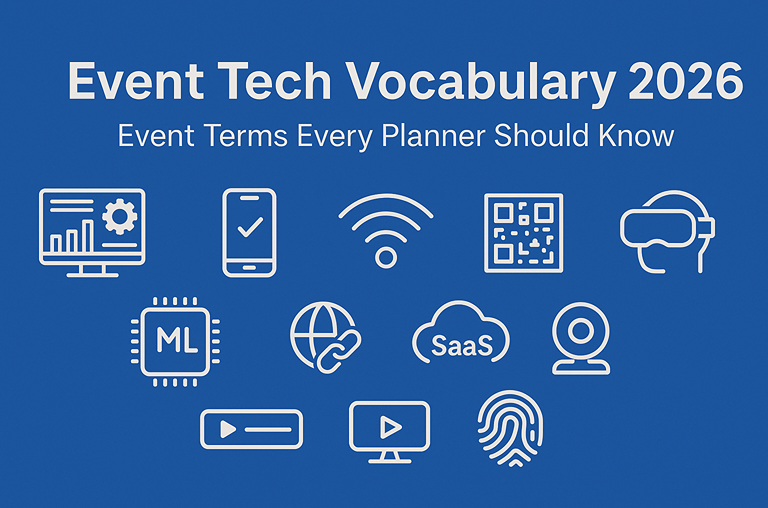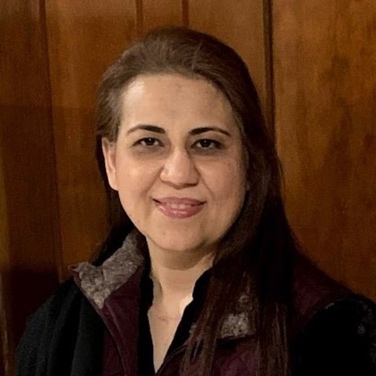
Event Tech Vocabulary 2026 – Event Terms Every Planner Should Know
Last Updated: November 21, 2025
Event technology has advanced faster in the past five years than in the previous decade combined. As we move deeper into 2026, planners are expected to understand the systems, software, digital tools, and technical language behind event management apps, event management platforms, hybrid event software, mobile conference apps, and event registration software.
This glossary contains 80+ verified acronyms and terms widely used across the U.S. events industry — by planners, AV teams, venues, corporate organizers, and event-tech professionals.
Let’s begin.
Core Event Technology & Software Terms
EMS — Event Management Software/System
Software used to plan, manage, deliver, and analyze events. Event management apps like Grupio fall under this category.
API — Application Programming Interface
A connector that allows your event app to work with CRMs, ticketing systems, check-in tools, and marketing platforms.
UX — User Experience
How easy, intuitive, and enjoyable the event mobile app feels for attendees.
UI — User Interface
The layout and visual design of the app’s screens, buttons, and navigation.
CMS — Content Management System
System used to manage schedules, speakers, exhibitors, documents, push notifications, and more.
SaaS — Software as a Service
Cloud-hosted event platforms accessed by login (e.g., event apps, registration systems).
SSO — Single Sign-On
Attendees log in using one set of credentials (Google, Microsoft, corporate login).
SAML — Security Assertion Markup Language
A secure method for authenticating SSO users.
NFC — Near Field Communication
Used for contactless check-ins and smart badges.
OCR — Optical Character Recognition
Technology used for badge scanning and document reading.
AR — Augmented Reality
Used in event apps for interactive venue maps, exhibitor product previews, and 3D overlays.
VR — Virtual Reality
Used for immersive demonstrations, virtual tours, or hybrid presentations.
AI — Artificial Intelligence
Used in networking matchmaking, personalized recommendations, chatbots, and event analytics.
ML — Machine Learning
A branch of AI that improves predictions over time.
BLE — Bluetooth Low Energy (Beacons)
Used for indoor positioning, heat maps, and attendee tracking.
PWA — Progressive Web App
A lightweight app accessed through the browser without installation.
RTMP — Real-Time Messaging Protocol
Technology used for livestreaming sessions in hybrid events.
CDN — Content Delivery Network
Used to ensure smooth video playback and fast app loading.
Engagement, Registration & Event Marketing Terms
QR — Quick Response Code
Used for mobile check-in, contactless entry, and lead retrieval.
EDM — Electronic Direct Mail
Email-based event marketing approach.
CTA — Call to Action
Buttons or prompts like “Register Now,” “Join Session,” “Download App.”
CTR — Click-Through Rate
Measures how many people clicked on your event marketing links.
UVP — Unique Value Proposition
What makes your event different or better (exhibitors, speakers, tech tools, sessions).
UGC — User-Generated Content
Photos, posts, and contributions made by attendees inside your event app.
ROI — Return on Investment
Total value generated vs. total cost.
ROO — Return on Objective
Success measured based on engagement or learning outcomes (not money).
CAC — Customer Acquisition Cost
How much it costs to attract an attendee or exhibitor.
ATT — App Tracking Transparency
Rules affecting user-tracking permissions on iPhones.
Hybrid, Virtual & Remote Event Technology
VOD — Video on Demand
Recorded sessions available after the event.
VoIP — Voice over Internet Protocol
Used for virtual speaker calls and digital communication.
ATS — Attendee Tracking System
Tracks attendance, movements, and session participation.
VEP — Virtual Event Platform
Platforms used to host and deliver online sessions.
Breakout Rooms
Virtual sub-sessions used for workshops, networking, and roundtables.
Latency
The time delay in livestreams — critical for speaker coordination.
Bandwidth
Required internet strength for streaming quality video.
Planning, Logistics & Onsite Operations Terms
BEO — Banquet Event Order
A document outlining catering requirements, schedules, room setups, and services.
RFP — Request for Proposal
Issued to venues, AV companies, and software providers for competitive bidding.
RFQ — Request for Quote
Used when gathering price comparisons.
SME — Subject Matter Expert
Specialized speaker or expert presenter.
AV / A/V — Audio Visual
Equipment and production teams responsible for microphones, screens, lights, and display systems.
F&B — Food and Beverage
Catering services and meal planning handled by venues.
CVB — Convention & Visitors Bureau
Local organization that supports event planning, venue selection, and tourism.
DMC — Destination Management Company
Handles local logistics, transportation, tours, and entertainment.
PAX — Number of Attendees
Common term in seating, catering, and registration.
ETA — Estimated Time of Arrival
Used for speakers, VIPs, vendors, and deliveries.
CAD — Computer-Aided Design
Used for booth layouts, venue maps, and production diagrams.
MOD — Manager on Duty
Primary operations manager during an event.
WBS — Work Breakdown Structure
Organizes tasks and timelines for event project management.
SOP — Standard Operating Procedure
Instructions for safety, operations, or vendor workflow.
Security & Compliance Terms (Critical for 2026)
GDPR — General Data Protection Regulation
Applies if your event includes European attendees.
CCPA — California Consumer Privacy Act
Regulates attendee data collection in the U.S.
MFA — Multi-Factor Authentication
2-step verification for secure access.
SSL — Secure Sockets Layer
Protects web traffic and event websites.
TLS — Transport Layer Security
Modern version of SSL encryption.
IP — Internet Protocol
Basic communication standard on networks.
VPN — Virtual Private Network
Used for secure communication between planners and vendors.
DDoS — Distributed Denial of Service Attack
Cyber threat that floods servers — relevant for virtual events.
KMS — Key Management Service
Used for managing encryption keys securely.
Venue, Production & Staging Terms
FOH — Front of House
Public-facing area where attendees interact (registration desk, seating, stage).
BOH — Back of House
Staff-only zones for operations and equipment.
LED — Light Emitting Diode
Screens, stage displays, and signage.
HDMI — High Definition Multimedia Interface
Standard display connector.
PTZ Camera — Pan-Tilt-Zoom Camera
Remotely controlled cameras used in hybrid events.
RF — Radio Frequency
Used for wireless microphones and communication systems.
Stage Plot
Diagram showing performer and AV equipment placement.
Show Flow / Run Sheet
Minute-by-minute production document for speakers, AV, and stage managers.
Attendee Experience & Event App Interaction Terms
NPS — Net Promoter Score
Measures attendee satisfaction and loyalty.
CEUs / CE Credits — Continuing Education Units
Used in academic, medical, scientific, and corporate training events.
RFID — Radio-Frequency Identification
Used for smart badges, tracking, and cashless payments.
Lead Retrieval
Tool exhibitors use to collect attendee details via QR or NFC.
Wayfinding
Digital maps inside event apps for navigation.
Gamification
Interactive challenges, quizzes, points, and leaderboards to boost engagement.
Push Notification
Real-time alerts sent to attendees’ devices.
Why Knowing Event Tech Terms Matters in 2026
As event technology becomes smarter and more integrated, planners must understand the vocabulary behind:
- Event mobile applications
- Mobile conference apps
- Event management platforms
- Event planning software
- Online conference apps
- Event registration software
- Hybrid event software
Whether you’re planning a conference, corporate event, expo, or hybrid meeting, a modern platform like Grupio makes it easy to manage schedules,
content, check-ins, engagement, analytics, and sponsors from one unified event app.

Zeena Awan is a dynamic Senior Project Manager at Grupio, recognized for her proven ability to lead complex, large-scale projects from inception to successful delivery. With extensive experience in project planning, execution, and process optimization, she excels at streamlining workflows, aligning cross-functional teams, and driving efficiency across operations.
Zeena is highly regarded for her strategic problem-solving skills, strong leadership, and commitment to excellence, consistently ensuring projects are delivered on time and to the highest standards of quality. At Grupio, she plays a pivotal role in enhancing operational processes, fostering collaboration, and implementing scalable solutions that align team performance with organizational goals. Her focus on both client satisfaction and team success has positioned her as a trusted leader in ensuring seamless project outcomes.


